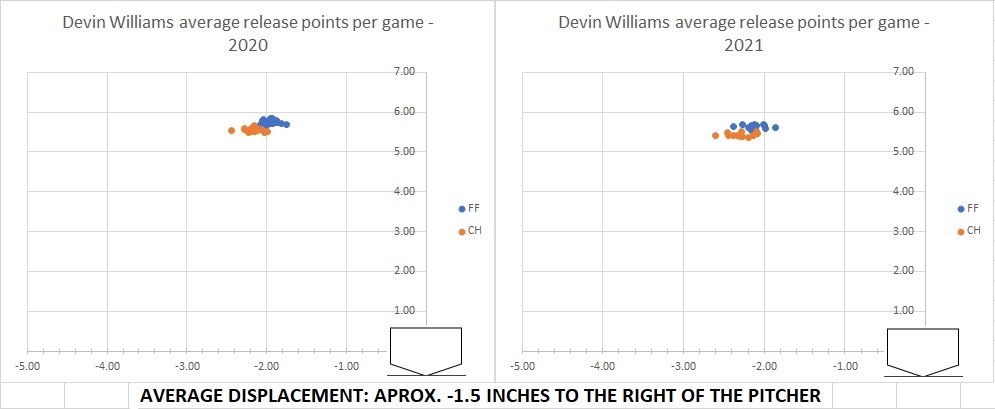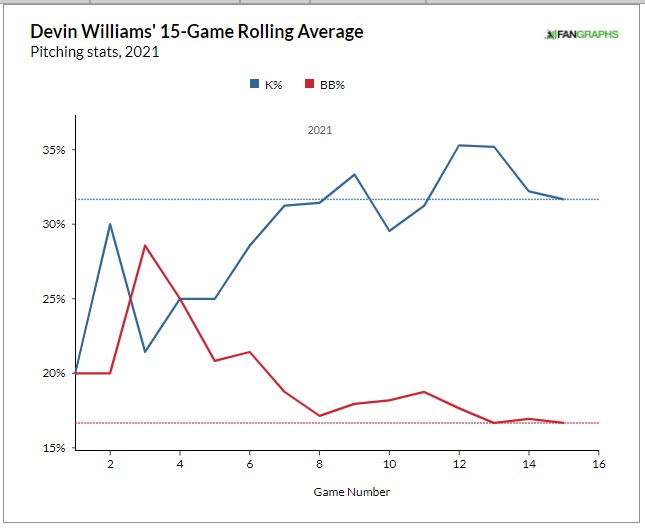Among the wide range of sayings and beliefs that populate baseball, the “curse” of the sophomore is one that persistently reappears. It is more commonly referred to as the Sophomore Slump or the Sophomore Jinx, and it is particularly pointed out when considering the Rookies of the Year from the previous season; in this case, Devin Williams.
Most of the time, this jinx is nothing more than our inability to handle small samples appropriately. We end up giving more weight than we should to short stints from new guys in the MLB than to their MiLB track record. This often causes us to get burned the following year when they regress to their actual capabilities.
Is this what is happening with Williams? Weren’t 27 innings pitched in 2020 enough to truly gauge what is his real self?
The Airbender
There is no Devin Williams, as we know him, without that other-worldly changeup he showed us last season, christened as The Airbender by Rob Friedman, aka @PitchingNinja.
Let’s refresh what are we talking about, looking at this tweet-gif from @PitcherList:
The Devin Williams Airbender is as devastating as ever pic.twitter.com/bX6ROpGTJm
— Nick Pollack (@PitcherList) March 24, 2021
That’s a thing of beauty, indeed.
In 2020, Williams’ changeup was the pitch that allowed the lowest wOBA in all MLB (min. 200 pitches), at .078, and if we lower the threshold to min. 100 pitches, it was third behind Blake Snell’s slider and Dylan Bundy’s curveball. At almost 53% usage, he threw his changeup at more than 3.5 times more than Snell’s slider and Bundy’s curve so, in absolute terms, his was a more efficient pitch, arguably the best in MLB last year.
Every time Williams appeared in a game, which was usually in a setup role for Josh Hader, it was an almost sure thing he would silence the opposite batters. His final line of a ridiculous 0.33 ERA, 44% K-BB%, 40.4 CSW%, 0.86 FIP while accumulating 9 holds, made him a worthy NL Rookie of the Year winner.
All this lead to his ADP (NFBC Draft Champions) jumping to 180 while being the 65th pitcher off the board even without the closer’s role; those ratios were just too enticing. Unfortunately, 2021’s version has been far from exciting.
The Unbender
While his changeup this year has been two times less effective than last year in terms of allowed wOBA at .171, batters are hitting it harder than last year: 86.4 mph in 2020 vs. 78.5 mph average exit velocity this year, and at a better average Launch Angle, -2 vs. 12 degrees. It is still a great pitch if we measure it by Statcast’s Run Value at -4 (it was -13 last year), meaning that it is a pitch that’s helped avoid four runs this year, which is very good. Now, the fastball, that’s another story as we can see in the following chart:

Williams’ heater was a regular pitch last year, serving its purpose of helping set the tone in every at-bat, providing enough deception for the changeup to do its thing, putting batters out of balance. Its Run Value of zero was innocuous enough for said purpose.
But this season, it has taken a turn for the worse: in way fewer opportunities it has allowed twice as many home runs than last year. Batters are hitting for a .400 batting average against it while slugging 1.000, too. Also, while last year his Whiff% (percentage of swings and misses against it) was almost 40%, this year is around three times worse at just 14.3%. It’s not fooling anyone.
You can’t have an effective Airbender if you accompany it with an Unbender, that just won’t do the trick. In a fantastic article by Lucas Spence (@lspence24) earlier this year about Dinelson Lamet, he points out how being a unidimensional pitcher because of his dependence on the amazing slider, made Lamet dependent on having at least an average fastball to make the slider effective:
“Lamet’s fastball surely isn’t his slider, but that’s not a very fair comparison. That would be like saying that Marvel’s The Avengers movie (2012) isn’t Infinity War (2018). Well of course it isn’t, as one is clearly superior to the other (in my humble opinion). But both are great in their own right, and The Avengers served as one of the foundational pieces on which the MCU was built, allowing for Infinity War to be the tremendous success that it was. Without The Avengers, there is no Infinity War. And without Lamet’s 100-mph fastball, the slider would not be as effective as it is”
This sums up very nicely what has happened with Devin Williams‘ arsenal this year. His fastball is not serving as the stepping stone for the changeup to do its damage. That’s a problem.
There are small things that could be making the four-seamer less effective: it’s down 1 mph in velocity compared to last year (96.4 mph vs. 95.4 mph) and that’s very important, It’s also spinning less, 2299 rpm vs. 2386 rpm, and while the active spin is up to 100% from 98%, it hast lost vertical movement, gaining horizontal movement, instead.
Williams has moved an inch and a half to his right side of the rubber, according to his release point data (the point at which he releases the ball in each throw to home), as we can see in the next graph.

Willingly or not, it looks like he is throwing his pitches from a slightly different position.
What to Expect
These few small changes add up little by little to become very important in terms of the final results. Sometimes there is not a major issue impacting the results. It is unfortunate because that makes it harder to spot the culprit and make adjustments.
In Devin Williams‘ case, I’m willing to bet that he and the Brewers’ pitching coaches will be able to tweak his mechanics and/or make small adjustments, so he can find his way back to a better four-seamer. That will not only make it a good weapon by itself but of course will impact the effectiveness of his changeup, hopefully to its not-so-old glory.
There are some signs that he is already improving in some areas. After a really rough start, his K% and BB% have been slowly improving in his last appearances as we can see in the following 15-game rolling averages graph:

This makes me hopeful that Williams will improve his performance for the rest of the season and, although he will naturally regress from his stellar 2020, he will still be the owner of one of the most incredible pitches in baseball and remain an elite relief pitcher.
Steamer has him for a 3.40 ERA and a 3.53 FIP rest of the season, I’m more optimistic and believe that an ERA in the vicinity of 3.00 is doable for him, while piling up 15 more holds with a 13 K/9.
Photo by Nick Wosika/Icon Sportswire | Adapted by Doug Carlin (@Bdougals on Twitter)

